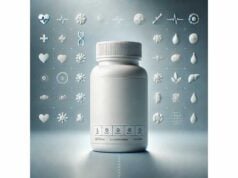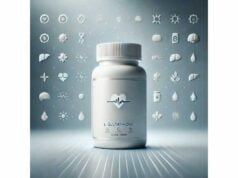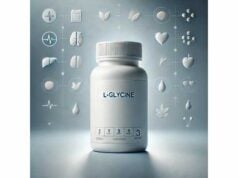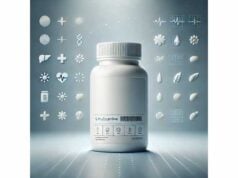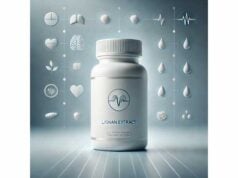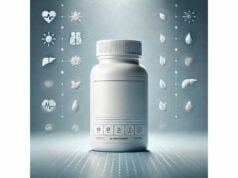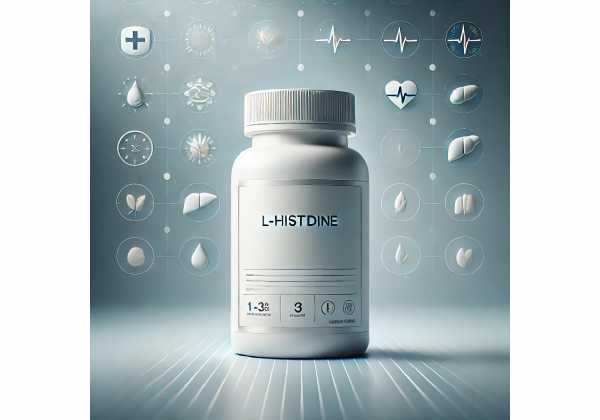
L-histidine is an essential amino acid with outsized impact for a small molecule. Beyond helping build proteins, it is a precursor to histamine (immune and gastric function), a partner in the antioxidant network, and a building block of carnosine, the pH-buffering dipeptide concentrated in muscle and brain. Research in humans links supplemental histidine with improvements in insulin resistance and skin barrier function in atopic dermatitis, while safety-focused trials outline tolerable daily intakes for healthy adults. Because histidine also coordinates metal ions and buffers protons through its imidazole ring, it shows up in enzyme active sites and supports everyday physiology from red blood cell formation to stomach acid regulation. This guide takes a people-first look at how histidine works, who it helps most, how to dose it for specific goals, where it fits with diet and other supplements, and what to watch for—especially around zinc status, very high intakes, and special situations such as pregnancy, kidney disease, and chronic liver conditions.
Essential Insights
- May improve insulin resistance and inflammation at 4 g/day over 12 weeks in adults with metabolic syndrome.
- Can support skin barrier integrity in atopic dermatitis programs, with practical results seen within 4–8 weeks.
- Typical supplemental range: 0.5–4 g/day, individualized by goal; short trials identified a no-observed-adverse-effect level near 8 g/day in healthy adults.
- Use caution at high doses: potential effects on zinc status and lab markers begin to appear above common ranges.
- Avoid or seek medical guidance if pregnant or breastfeeding, with chronic kidney or significant liver disease, or on medications where histamine modulation poses risk.
Table of Contents
- What is L-histidine and how it works
- Evidence-backed benefits you can expect
- Who benefits most and who should avoid it
- How to take L-histidine day to day
- How much histidine per day? Dosage by goal
- Side effects, interactions, and safety checklist
What is L-histidine and how it works
L-histidine is one of the nine indispensable amino acids—your body cannot make it in sufficient amounts, so it must come from food or supplements. It is abundant in animal proteins (meat, fish, dairy) and present in plant sources such as soy, legumes, and whole grains. As an amino acid, histidine is incorporated into thousands of proteins, but several features make it uniquely influential:
1) Imidazole chemistry and pH buffering.
Histidine’s side chain (an imidazole ring) can accept or donate a proton near physiological pH. That makes histidine a go-to residue in enzyme active sites and contributes to intracellular and intramuscular buffering. When combined with beta-alanine to form carnosine in skeletal muscle, histidine helps resist acid buildup during intense exercise; beta-alanine is usually the rate-limiting substrate for carnosine synthesis, but adequate histidine intake remains important.
2) Precursor to histamine and other bioactive molecules.
Histidine decarboxylase converts histidine into histamine, a signaling molecule central to immune responses, gastric acid secretion, and neurotransmission. This link explains why histidine status can influence stomach function and, in specific contexts, immune or allergy-like reactions.
3) Metal ion coordination and antioxidant roles.
Histidine is involved in binding metals such as zinc and copper within proteins. Through histidine-rich peptides and its contribution to carnosine, it supports cellular defenses against oxidative stress and reactive carbonyls. This is one reason histidine shows up in research on metabolism and healthy aging.
4) Skin barrier and filaggrin connection.
In the epidermis, filaggrin is rich in histidine. As filaggrin breaks down, it releases histidine that contributes to the skin’s “natural moisturizing factor.” Supplemental histidine has been studied as a way to augment this pathway in atopic dermatitis programs.
Absorption and practicalities.
Histidine is absorbed in the small intestine via amino acid transporters; as a free-form supplement, it does not require complex delivery systems. It mixes well with water or can be taken in capsules.
What it is not.
Histidine is not a stimulant or a sedative. Its effects are typically indirect—through buffering, antioxidant support, histamine pathways, or carnosine formation—so benefits are usually noticed over weeks, not hours.
Evidence-backed benefits you can expect
Metabolic support in adults with metabolic syndrome.
In a randomized, double-blind, placebo-controlled trial in obese women with metabolic syndrome, 4 g/day of histidine for 12 weeks led to meaningful improvements in insulin resistance (lower HOMA-IR), reductions in inflammatory cytokines, and favorable shifts in adiponectin and oxidative stress markers. Waist circumference and fat mass also decreased modestly over the study window. Practically, people who respond describe steadier post-meal energy and less afternoon slump after several weeks. While this is a single, well-conducted trial in a defined population, it anchors histidine’s metabolic profile in humans and justifies a 4 g/day “therapeutic” tier under professional guidance for those goals.
Skin barrier support in atopic dermatitis programs.
Adults with atopic dermatitis given daily L-histidine experienced clinically relevant reductions in disease severity scores within 4–8 weeks, aligning with histidine’s contribution to filaggrin processing and natural moisturizing factor. For many, the appeal is that histidine is non-sedating and works from the “inside-out,” complementing topical regimens. It is not a cure for eczema, but it may nudge the barrier toward better hydration and resilience.
Exercise and performance (indirect).
Carnosine—made from beta-alanine and histidine—buffers intramuscular pH during high-intensity work. Beta-alanine availability usually limits carnosine synthesis, so beta-alanine is the star for performance. Adequate histidine intake still makes sense for athletes who under-consume protein, avoid meat, or train hard in cut phases; it helps ensure the carnosine “assembly line” is not missing parts, and it supports hemoglobin formation for oxygen transport.
Gastric and mucosal considerations.
Histamine derived from histidine promotes gastric acid secretion, which can aid protein digestion. That said, individuals with reflux or sensitive gastric mucosa may need to monitor symptoms, especially when combining histidine with other triggers.
Healthy aging, brain, and redox balance (emerging).
Reviews synthesize early human and mechanistic evidence that histidine and histidine-containing dipeptides may help temper oxidative and carbonyl stress and support mitochondrial health. Some groups are exploring histidine’s role in cognitive domains through carnosine biology. These signals are promising but preliminary; expect more data over the coming years.
Where evidence is mixed or negative.
Older trials in dialysis populations did not find histidine alone improved anemia outcomes; if histidine has a role in anemia management, it likely depends on broader iron handling and clinical context rather than histidine as a single agent. Keep this nuance in mind if you encounter historic claims.
Time course for noticing benefits.
- Metabolic markers: allow 8–12 weeks at consistently dosed intakes.
- Skin barrier: some respond within 4 weeks, with fuller effects by 8–12 weeks.
- Training support: think “foundation,” not a performance booster—pair with adequate protein and (if appropriate) beta-alanine.
Who benefits most and who should avoid it
Most likely to benefit
- Adults with features of metabolic syndrome who are already addressing diet quality, movement, and sleep. A histidine trial at 4 g/day can be considered with clinician oversight to monitor fasting glucose, insulin resistance indices, triglycerides, and inflammatory markers.
- People with atopic dermatitis following a dermatologist-directed plan; histidine may complement topical therapy by supporting filaggrin processing and hydration.
- Athletes and highly active people with low-histidine intake (e.g., low total protein or limited animal protein) who want to ensure carnosine and hemoglobin building blocks are on hand.
- Individuals with low-protein dietary patterns (including some older adults) where essential amino acid coverage is marginal.
Useful as an adjunct, not a stand-alone
- Weight management and metabolic health programs. Histidine may help with inflammatory tone and insulin resistance but works best alongside a protein-sufficient diet, resistance training, fiber-rich meals, and high-quality sleep.
- Skin barrier repair routines. Expect incremental improvement; maintain emollients and avoid irritant triggers.
Who should avoid or seek medical advice first
- Pregnancy and breastfeeding. Safety as a stand-alone supplement is not well established. Avoid unless specifically recommended by your clinician.
- Chronic kidney disease (especially moderate to advanced). Extra nitrogen and amino acid loads require individualized oversight.
- Significant liver disease. Historical reports link higher histidine intakes with adverse shifts in ammonia and amino acid balance in hepatic impairment; specialist input is essential.
- Histamine-related conditions. Because histidine is a histamine precursor, individuals with mast cell disorders or severe histamine intolerance should proceed only with clinician guidance.
- Active peptic ulcer disease or severe reflux. Monitor symptoms; discontinue if worsening occurs.
Medication considerations
- Acid-suppressing drugs. Theoretical interactions with gastric physiology are generally modest at nutritional doses, but symptom tracking helps.
- Antihistamines and mast cell–directed therapies. Discuss histidine use with your prescriber if your regimen modulates histamine pathways.
Allergies and sensitivities
- True histidine allergy is exceedingly rare. Most adverse experiences are dose-related (e.g., nausea) and improve by reducing the dose or taking with food.
How to take L-histidine day to day
Forms and flavor
- Powder: Neutral to slightly bitter; dissolves in water or mixes into smoothies. Easy for 1–2 g titrations.
- Capsules: Convenient for fixed doses (e.g., 500–1000 mg per capsule).
- Protein-based sources: Many people can meet needs with protein-rich foods; supplementation fills targeted gaps.
Timing by goal
- Metabolic health programs: Split doses with meals (e.g., 1 g at breakfast and 1–3 g at main meals to reach your daily target).
- Atopic dermatitis support: Once-daily dosing is common in studies; consistency across weeks is more important than clock time.
- Training support: Ensure overall protein sufficiency first. If supplementing, take histidine with a main meal; pair training nutrition with beta-alanine if your specific goal is to raise muscle carnosine.
Stacking examples
- Metabolic stack (food-first): Emphasize 1.2–1.6 g protein/kg/day total, high-fiber meals, omega-3 fats, sleep regularity; add histidine 2–4 g/day as a 12-week trial with lab tracking.
- Skin barrier stack: Emollients + trigger avoidance + histidine 1–4 g/day for 8–12 weeks; consider vitamin D sufficiency and gentle skincare routines.
- Athlete foundation: Adequate protein + beta-alanine (if appropriate) + histidine via diet or 0.5–1 g/day in low-intake phases.
Mixing and adherence tips
- Start low and increase gradually to your target dose over 3–7 days.
- Take with food if you notice mild nausea.
- For powders, pre-portion into small sachets for travel or keep capsules in a pill case.
How to judge if it is working
- Metabolic goals: Reassess fasting glucose, HOMA-IR (if available), triglycerides, waist circumference, and energy stability after 8–12 weeks.
- Skin goals: Track validated scores (e.g., SCORAD or patient-reported itch and sleep interference) at baseline and every 4 weeks.
- Training: Watch subjective recovery and performance consistency rather than expecting acute boosts.
When to stop or adjust
- Persistent GI upset, new or worsening reflux, headaches, or signs of histamine sensitivity warrant pausing.
- If lab monitoring shows declining zinc or concerning liver enzymes at higher intakes, discontinue and treat deficiencies before reconsidering use.
How much histidine per day? Dosage by goal
Everyday nutritional support
- Many adults meet histidine needs through diet alone. When supplementing for general support, 0.5–2 g/day is a pragmatic starting range that fits easily with meals and has a wide safety margin in healthy individuals.
Metabolic syndrome or insulin resistance (trial-based template)
- 4 g/day divided with meals for 12 weeks mirrors a successful, controlled human trial in obese women with metabolic syndrome. If you and your clinician pursue this, plan baseline and follow-up checks for fasting glucose/insulin, inflammatory markers, and anthropometrics.
Atopic dermatitis (barrier support)
- 1–4 g/day as a daily dose over 4–12 weeks is commonly used in adult programs; some pilot work used 4 g/day with improvements by week 4. Maintain topical therapy and skincare habits during the trial.
Athletes and highly active people
- If dietary histidine is low, 0.5–1 g/day can bolster intake. For carnosine-specific goals, beta-alanine—not histidine—is the primary lever, but histidine sufficiency supports the overall milieu.
Ceilings, NOAEL, and high-dose contexts
- Short, graded-dose human work identified a no-observed-adverse-effect level around 8 g/day in healthy adults, with changes in some blood parameters appearing at ≥12 g/day. Reports at very high intakes (≥24 g/day) describe decreased serum zinc and other lab shifts. These upper tiers are outside routine wellness use and should not be attempted without clinical supervision and lab monitoring.
Cycling and duration
- Metabolic goals: commit to 8–12 weeks, then reassess.
- Skin goals: evaluate at 4 and 8–12 weeks.
- Maintenance: if you benefit and tolerate well at 0.5–2 g/day, long-term use may be reasonable with periodic breaks and annual lab work (including zinc status, especially if intake creeps higher).
Special populations
- Pregnancy/breastfeeding: avoid routine supplementation unless directed by your clinician.
- Kidney or significant liver disease: individualized medical oversight is required; avoid self-directed high dosing.
Side effects, interactions, and safety checklist
Typical tolerability
- At nutritional doses (≤2–4 g/day), histidine is usually well tolerated. The most common complaint is mild GI discomfort when taken on an empty stomach; taking with meals often resolves it.
High-dose considerations
- As intake rises above common ranges, labs can shift: decreases in serum zinc and changes in ferritin or liver enzymes have been observed at ≥12–16 g/day in short studies, even when values remained within reference ranges. Very high intakes (≥24 g/day) have been associated with zinc depletion and adverse symptoms. These levels are not appropriate for self-experimentation.
Histamine-related effects
- Because histidine is a histamine precursor, sensitive individuals could notice flushing, itch, or reflux-like symptoms. If you have mast cell disorders or significant histamine intolerance, consult your clinician before use.
Kidney and liver cautions
- Extra amino acid nitrogen increases renal handling; individuals with chronic kidney disease should avoid unsupervised supplementation. In liver disease, higher histidine can unfavorably alter ammonia and amino acid balances; specialist guidance is essential.
Drug and supplement interactions
- Zinc: high-dose histidine can chelate zinc and increase urinary losses; if long-term higher dosing is medically indicated, monitor zinc and consider dietary compensation or careful repletion.
- Acid-suppressive medications: symptom interplay is possible but typically minor at nutritional doses; simply monitor.
Quality and purity
- Choose products with third-party testing (e.g., NSF, USP, Informed Choice). Pure supplements should list L-histidine and capsule ingredients only. Avoid proprietary blends that obscure dose.
When to stop and seek care
- New rash, swelling, wheeze, severe GI distress, or neurologic symptoms.
- Lab abnormalities (declining zinc, rising liver enzymes) on routine monitoring.
- Worsening reflux or histamine-type symptoms that do not settle with dose reduction.
Practical safety summary
- For most healthy adults, 0.5–2 g/day is conservative and practical; 4 g/day can be considered short term for targeted goals under guidance. Avoid pushing beyond these ranges without clinical oversight and clear monitoring plans.
References
- Histidine supplementation improves insulin resistance through suppressed inflammation in obese women with the metabolic syndrome: a randomised controlled trial 2013 (RCT)
- Feeding filaggrin: effects of l-histidine supplementation in atopic dermatitis 2017 (Human trial)
- Tolerance to graded dosages of histidine supplementation in healthy human adults 2020 (Dose–response trial)
- Benefits and Adverse Effects of Histidine Supplementation 2020 (Review)
- Histidine in Health and Disease: Metabolism, Physiological Importance, and Use as a Supplement 2020 (Review)
Medical Disclaimer
This article is for educational purposes and does not replace personalized medical advice, diagnosis, or treatment. Always consult a qualified healthcare professional before starting any new supplement—especially if you are pregnant or breastfeeding, have chronic kidney or significant liver disease, take prescription medications, or manage histamine-related conditions. If you experience adverse effects, stop the supplement and seek medical care.
If this guide helped you, please consider sharing it with a friend or on Facebook or X (formerly Twitter), and follow our work for more evidence-informed health articles. Your support helps us continue creating high-quality, people-first content.

